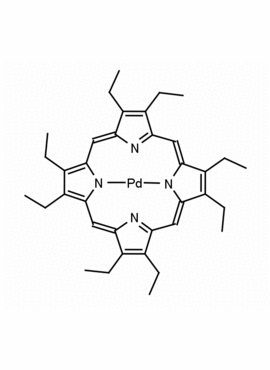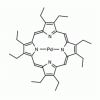Pd(II) Octaethylporphine 21H,23H-Porphine,2,3,7,8,12,13,17,18-octaethyl-palladium complex CAS: 24804-00-0 MDL: MFCD00192364
Molecular weight: 639.181 g/mol
Molecular Formula: C36H44N4Pd
CAS Number: 24804-00-0
Storage: Store at room temperature, protect from light.
Synonyms: [2,3,7,8,12,13,17,1
Fields of Interest: phosphorescent oxygen sensors, triplet sensitizer, one photon absorption OPA,
Background: Pd(II) Octaethylporphine is a synthetic porphyrin specialty chemical manufactured by Frontier Specialty Chemicals. The triplet sensitizer Pd(II) octaethylporphine (PdOEP) was found to possess absorption involving a hot vibrational energy-level, resulting in one-photon absorption (OPA) upconversion emission.1 A sol-gel doped with Pd(II) octaethylporphine was used as a high performance optical trace oxygen sensor.2 Pd(II) Octaethylporphine acts as a triplet sensitizer for the frequency upconversion of light in the presence of a suitable acceptor/ annihilator such as 9,10-diphenylanthracene.3 The photophysics of Pd(II) Octaethylporphine at 77 K and room temperature have been reported.4,5 Noncoherent sensitized green-to-near-visible upconversion has been achieved utilizing palladium(II) octaethylporphyrin (PdOEP) as the triplet sensitizer.6 A recent review on triplet-triplet annihilation upconversion has been published.7
References:
1.) Ju, et al. A novel low-powered upconversion strategy to enhance the anti-Stokes shift: cascading one-photon hot-band absorption and triplet sensitization based on Pd(ii)octaethylporphyrin. J. Mater. Chem. C, 2021,9, 6749-6753. https://doi.org/10.1039/D1TC00721A
2.) Wang, et al. A high-performance optical trace oxygen sensor based on the room-temperature phosphorescence from palladium (II) octaethylporphyrin. Measurement. Volume 206, January 2023, 112275. https://doi.org/10.1016/j.measurement.2022.112275
3.) Haefele, et al. Getting to the (Square) Root of the Problem: How to Make Noncoherent Pumped Upconversion Linear. J. Phys. Chem. Lett. 2012, 3, 3, 299–303. https://doi.org/10.1021/jz300012u
4.) Singh, et al. Phosphorescence spectra and triplet state lifetimes of palladium octaethylporphyrin, palladium octaethylchlorin and palladium 2,3-dimethyloctaethylisobacteriochlorin at 77 K. Spectrochimica Acta Part A: Molecular and Biomolecular Spectroscopy. Volume 59, Issue 5, 15 March 2003, Pages 905-908. https://doi.org/10.1016/S1386-1425(02)00258-5
5.) Losev, et al. Absorbance and emission properties of palladium octaethylporphyrin and palladium tetrahexylporphyrin in solution and in phospholipid membranes. Journal of Photochemistry and Photobiology B: Biology. Volume 7, Issues 2–4, November 1990, Pages 181-187.
6.) Deng, et al. Annihilation Limit of a Visible-to-UV Photon Upconversion Composition Ascertained from Transient Absorption Kinetics. J. Phys. Chem. A 2013, 117, 21, 4412–4419. https://doi.org/10.1021/jp4022618
7.) Bharmoria, et al. Triplet–triplet annihilation based near infrared to visible molecular photon upconversion. Chem. Soc. Rev., 2020, 49, 6529-6554. 10.1039/D0CS00257G

